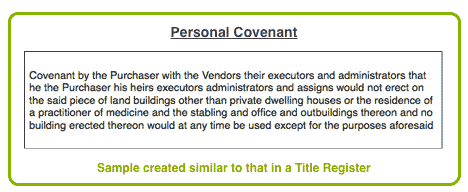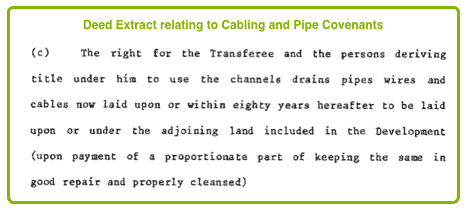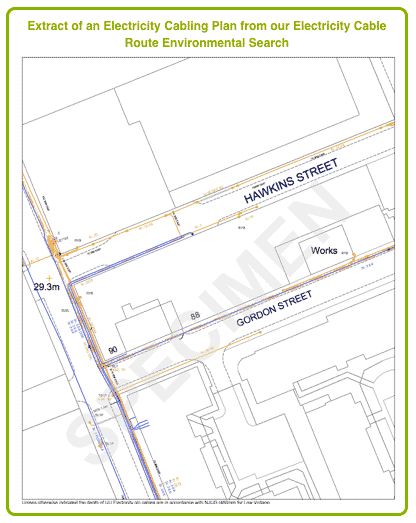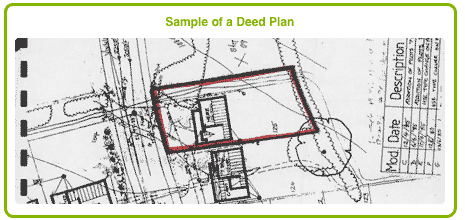Property History
Since April 2003, when the Land Registry digitised their records, it has been possible to obtain prior copies of the Title Register. However, many people wish to investigate the history of their property going back far further than 2003. This is best done by obtaining copies of older deeds and other documents retained by the Land Registry.
Our Deed Searches are particularly popular with genealogists and new home owners. Often a property's deeds will date back to the 18th and 19th centuries and may provide a wealth of historical information.
Boundary Details
Title Registers often contain a statement referring to a deed that contains details of boundary structure notices and other information relating to property boundaries. Such can be very useful in helping to settle a boundary dispute. Full details of these are contained in our Property Boundaries section.
In addition, where the property is of a leasehold tenure, there may be considerable detail in one or more deeds, describing ownership and maintenance of dividing walls, as in the following extract.
Contents of a typical Conveyance or Transfer
- Name and address of the purchasers
- Name and address of the person selling the property to them
- Detailed description of the property address, which may include land measurements, hectarage, precise location and boundaries
- Purchase price
- Name and address of purchasers solicitors
- Easements, covenants, agreements, exceptions, reservations, and restrictions
- Name, address and occupation of witnesses to the deed
- Sometimes, a plan or drawing illustrating borders, rights of way, etc.
Covenants
Restrictive Covenants
Restrictive Covenants are covenants made between a purchaser and vendor, that "run with the land" and burden a property, for example, a covenant not to develop the land or to use it for commercial purposes. Such covenants, because they run with the land, burden it even if the property is sold to someone else. Restrictive Covenants are recorded in the C section of the Title Register; if lengthy, they may appear in a Schedule at the end of the C section. More detail of the Covenants is usually contained in the Deeds that the Land Registry retain with the Title Register, and from which the details in the Register have been created.

Personal Covenants
Personal Covenants are covenants which do not run with the land, and usually relate to an action that the Purchaser has agreed to take when buying the property, e.g. erecting a stock proof fence. They do not burden the land and are only enforceable against the person making the covenant, although a new owner is usually required to enter into a covenant in similar terms when buying the property. They are recorded in the B section of the Register, and are usually detailed more thoroughly in the Deed from which the entry was created.

Easements
Easements are private rights, such as a right of way, that permit you to use another person's property without owning it. There are four main categories of easements (or rights), over an adjoining parcel of land. These are rights of way, rights of light and air, rights of support and rights relating to artificial waterways.
All easements have similar properties in that:
- There must be two adjoining properties; one of which has the benefit of the right, known as the dominant tenement (this is a positive easement), and one which has the burden of the right, known as the servient tenement (this is a negative easement).
- The owners of the two properties must be different from each other.
- The right must be recorded by deed and in the case of registered land, should be recorded in the Title Register for each property affected.
Easements may arise in 6 different ways:
Express Easements
An express easement is expressed to be so by deed and in the case of registered land is referred to in the A Section of the Title Register for the dominant tenement (the land having the benefit of the easement) and in the C Section of the Title Register for the servient tenement (the land burdened by it).
An example of an express easement is where, on the sale of part of a parcel of land the vendor agrees that the purchaser may have a right of way along his drive. This will be recorded in the transfer deed and an entry will by made by the Land Registry in the A section of the purchaser's new Title Register and in the C section of the vendor's Title Register.
Implied Easements
Implied easements are not created by deed but are implied by the law, the courts looking at what the original parties intended and how the property is being used.
Easements of Necessity
An easement of necessity only comes into existence once the court makes an order for the same. Usually the easement is required because a property owner cannot obtain entrance to his land without crossing an adjacent parcel of land, i.e. his property is landlocked. In such circumstances application must be made to the court for the easement on the grounds that it is necessary for the enjoyment of the property. A similar right might exist where a gable wall requires repair but cannot be reached save by accessing an adjoining property.
The court will decide whether to grant the easement by deducing the intention of the original parties and whether the damage or inconvenience would be greater for the dominant or the servient tenement and make an order accordingly.
Once the need for an easement of necessity ceases to exist, e.g. because an access path is made or because a legal easement is created by deed, then the easement of necessity automatically ceases to exist.
Easements by Prior Use
It is possible to create an easement simply by having used the property in a similar way before. The court will assume that the parties intended to create it but forgot to declare the easement in the deeds.
In order for such an easement to exist it must be shown that:
- Both properties were once in the joint ownership of a person or persons.
- The properties were divided.
- That the use for which the easement is required existed before the properties were divided.
- That the easement was patently obvious, i.e. is discernible by inspection.
- The easement is reasonably necessary and will benefit the dominant tenement.
Easements by Prescription
Easements by prescription are similar to claims for adverse possession (or squatter's claims) in that they follow the use of land, without the owner's consent, openly and over a continuous period of at least 20 years. The main difference is that the use of the land is shared by more than one person. If the owner of the property acts to defend his property rights at any time before the above period has expired then the prescriptive right will cease, and any attempt to re-establish it will have to begin again.
Easements by prescription may arise under the common law, under the Prescription Act 1832 or by lost modern grant.
The right of way claimed must be one that could have been granted in accordance with the law. For example a right of way claimed for the purpose of tipping rubbish unlawfully on land could not have been lawfully granted and cannot be acquired by prescription. On the other hand, a right to drive a vehicle over land that is a restricted byway without lawful authority is an offence, but as lawful authority could have been given then such a right is capable of being acquired by prescription.
It should be noted that prescriptive rights cannot be acquired over railway land or land owned by the British Waterways Board, due to the operation of the British Transport Commission Act 1949.
Easements by Estoppel
Easements by estoppel are created by the court to prevent an inequitable outcome where the vendor has misrepresented that he would grant an easement to the purchaser but in fact did not expressly grant the same. If the purchaser bought the property and relied in good faith on the existence of such an easement as part of his decision to buy then the court will normally make an order for the easement.
For example, the purchaser may tell the vendor that he wishes to build a garage on part of the land being sold to him and the vendor may agree that he can access the garage by using a particular drive on his land. If no easement is granted by deed to effect such a right, but the purchaser has relied on the vendor's representation in consideration of purchasing the property then he would be entitled to an easement by estoppel.
Routes of & Access to Cables, Pipes & Sewers
Deeds often provide details of cables, pipes, sewers, watercourses and the like; sometimes their actual position is shown on a deed plan. Covenants relating to the same are often very detailed.

If the precise location of cables and pipes, etc are required but not described in a Deed or Deed Plan an Environmental Search can be made from the following website, where there is a choice of obtaining a detailed plan of water pipes and sewers, electricity cables, gas pipes, telephone wires, etc. Environmental searches can be viewed by visiting www.landregistryservices.com/environmental/.

Maintenance Obligations
It is often the case that a property owner is liable for the maintenance and upkeep not only of his property but of a wall or boundary abutting an adjoining property. The Title Register will normally provide details of this, however briefly; it is prudent to obtain a copy of the deed referring to that obligation, which will almost certainly be available to purchase, in order to obtain more detail of the obligation.
Deed Plans
A Deed will often have annexed to it a Plan (a Deed Plan) to make perfectly clear the property being described in the Deed. Unlike a Title Plan, the Deed Plan will often contain detailed measurements, angles, T and H marks, and other identifying features. This information can be immensely useful when attempting to resolve a boundary dispute, prove a right of way or identify a particular parcel of land subject to covenants etc.

Declarations of Trust
A Trust Deed is often prepared solely to declare a property in trust for another or others. This is likely to happen where there is more than one purchaser and they wish to own the property as Tenants in Common rather than Beneficial Joint Tenants. They will usually wish to spell out the respective percentages in the property that they each own, especially if they have made unequal contributions to the purchase price. Further, this will enable them to Will away their share upon the death of either of them.
A copy of the Declaration of Trust (Trust Deed) will be lodged with the Land Registry when the new ownership of the property is registered, and this will usually be kept as a digital copy.
Prior to compulsory registration of title a declaration of trust would be the only evidence of the existence of a Tenancy in Common.
Root of Title
Where a property has not previously been registered at the Land Registry it is necessary for the purchaser's solicitor to prove a good root of title, i.e. to check that all the sales and mortgages affecting the property have a correct and unbroken chain going back for at least 15 years, and that each of the vendors during the root of title period, had an unfettered title to sell the property, i.e. they were not bankrupt or in any other way incapacitated so as not to be able to own a property.
This is done by checking each of the ownership and similar deeds (conveyances, assents, memoranda, abstracts, powers of attorney, etc). The root of title was often summarised in the form of an Epitome of Title or Abstract of Title. Where the deeds themselves are not available, and where the contents of such documents contain useful information, such documents are often retained by the Land Registry either in digital or paper form. Such documents may be useful to historians for researching the history of a property.
Copies of Counsel's Opinions
Counsel's opinions are often retained by the Land Registry where they have been lodged in connection with a boundary or other dispute. This is an example of the type of document that can be obtained using our LR3d search, which pertains to miscellaneous documents and applications made to the Land Registry.
Purchase Price Prior to 2000
The Land Registry almost always notes the purchase price of the property on the Title Register, in the B section, but only where the property was purchased after the year 2000. Otherwise, the purchase price is included unless a successful application is made by the purchaser to exclude it, or if the Land Registry consider that including it would mislead the public, e.g. where the property was purchased with other properties and the individual purchase prices cannot be reasonably estimated.
Where a person is anxious to obtain the purchase price, but it is not included in the Register, then he may obtain a copy of the Purchase Deed (the Transfer or Conveyance), as that will include a consideration clause and will state the amount of purchase price.
Where the property was not actually purchased for money it will state any other consideration, e.g. the natural love and affection of Mr X. If the property was gifted it will state as such.
Ownership Prior to 1993
Where a person wishes to know the identity of the owners prior to the existing ownership he can obtain a copy of the Prior Title, using our s. However, it is only possible to obtain prior copies back to 1993 when the Land Registry began digitising their records.
Prior to this date it is necessary to obtain a copy of the purchase deed (Transfer or Conveyance), which will show the names and addresses of the vendors and purchasers and also the solicitors acting for them.